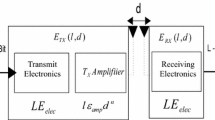Abstract
Clustering allows hierarchical structures to be built on the nodes and enables more efficient use of scarce resources, such as frequency spectrum, bandwidth, and energy in wireless sensor networks (WSNs). This paper proposes an energy efficient clustering algorithm for self-organizing and self-managing high-density large-scale WSNs, called SNOW cluster. It introduces region node selection as well as cluster head election based on the residual battery capacity of nodes to reduce the costs of managing sensor nodes and of the communication among them. Each sensor node autonomously selects cluster heads based on a probability that depends on its residual energy level. The role of cluster heads or region nodes is rotated among nodes to achieve load balancing and extend the lifetime of every individual sensor node. To do this, SNOW cluster clusters periodically to select cluster heads that are richer in residual energy level, compared to the other nodes, according to clustering policies from administrators. To prove the performance improvement of SNOW cluster, the ns-2 simulator was used. The results show that it can reduce the energy and bandwidth consumption for clustering and managing WSNs.
This research was funded by Dual Use Technology Program and ADD Korea and has been conducted by the Research Grant of Kwangwoon University in 2007.
Preview
Unable to display preview. Download preview PDF.
Similar content being viewed by others
References
Ruiz, L.B., Nogueira, J.M., Loureiro, A.A.F.: MANNA: A Management Architecture for Wireless Sensor Networks. IEEE Communications Magazine 41(2) (2003)
Song, J.-S., Cha, S.-H., Choi, J.: A Self-management Framework for Wireless Sensor Networks. In: Shen, H.T., et al. (eds.) APWeb Workshops 2006. LNCS, vol. 3842, pp. 206–213. Springer, Heidelberg (2006)
The VINT Project, The network simulator - ns-2, http://www.isi.edu/nsnam/ns/
Zhao, F., Guibas, L.: Wireless Sensor Networks: An Information Processing Approach. Morgan Kaufman, San Francisco (2004)
Karl, H., Willing, A.: Protocols and Architectures for Wireless Sensor Networks. John Wiley & Sons, Chichester (2005)
Heinzelman, W., et al.: Energy-Efficient Communication Protocol for Wireless Microsensor Networks. In: Proc. IEEE Int. Conf. System Sciences, vol. 8 (January 2000)
Heinzelman, W.: Application-Specific Protocol Architectures for Wireless Networks. PhD thesis, Massachusetts Inst. of Technology (June 2000)
Nano-24: Sensor Network, Octacomm, Inc., http://www.octacomm.net/
Author information
Authors and Affiliations
Editor information
Rights and permissions
Copyright information
© 2007 Springer Berlin Heidelberg
About this paper
Cite this paper
Cha, SH., Jo, M. (2007). An Energy-Efficient Clustering Algorithm for Large-Scale Wireless Sensor Networks. In: Cérin, C., Li, KC. (eds) Advances in Grid and Pervasive Computing. GPC 2007. Lecture Notes in Computer Science, vol 4459. Springer, Berlin, Heidelberg. https://doi.org/10.1007/978-3-540-72360-8_37
Download citation
DOI: https://doi.org/10.1007/978-3-540-72360-8_37
Publisher Name: Springer, Berlin, Heidelberg
Print ISBN: 978-3-540-72359-2
Online ISBN: 978-3-540-72360-8
eBook Packages: Computer ScienceComputer Science (R0)




